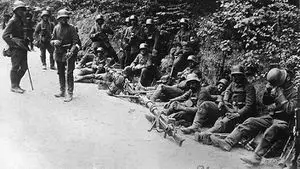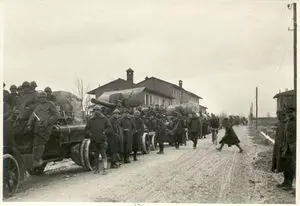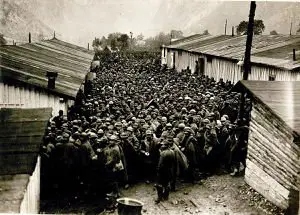Why did the Italians lose the Battle of Caporetto in WWI
The Battle of Caporetto was one of the most decisive battles of the First World War. The battle pitted the Italians against a combined Austro-Hungarian-German army. The battle was a decisive defeat for the Italians and it effectively meant that they had only limited influence on the war until the closing stages of the conflict. The battle was also important as it relieved pressure on the Austrians who were in trouble in 1917. This article will discuss the reasons for the decisive German and Austrian victory at the battle. The reasons for the success of the Germans and Austrians at the battle was the superior German tactics, the use of elite German Stormtroopers and poor Italian commanders and tactics.
Background
Italy was originally allied with Germany and the Austro-Hungarian Empire but did not join the Central Powers in 1914 in declaring war on the western allies. However, by 1915, the political elite and the intelligentsia wanted Italy to join the war. The nationalists in Italy saw the war as an opportunity for their nation to join the great powers. They also wanted to enter the war in a bid to unify the country. Some fifty years after the unification of Italy, the country was still divided upon regional lines.[1] North and South Italy were very different regions and many of the country’s citizens still place their region before their country. The nationalists believed that a war would complete the process of unification in Italy and encourage all the citizens to be patriotic Italians.[2] Furthermore, they believed that the nationalist fervour that would coincide with the war would mean that the socialists, who were pacifist would be marginalised.
The western allies approached Italy to join their cause. They offered the Italian government inducements such as territory from Austro-Hungary and also new colonies in Africa and Asia. This convinced the Italian government to join the western alliance.</ref> Keegan, p. 124</ref> This was despite the fact that the Italian army was poorly prepared and had little recent battle experience. The army was made up mainly of conscripts, many of who did not feel very ‘Italian’ and regarded themselves as Sicilians or Sardinians. This army was led by General Luigi Cardona who was to prove a very unimaginative and uninspiring leader and rated by one modern authority ‘as ineffectual’ [3]
The main theatre for the Italian army was its frontier with the Austro-Hungarian Empire. The Italians had fought many wars with this Empire in the 19th century and many saw them as their nation’s chief enemy. Much of the fighting between the Austrians and the Italians was to take place in the Isonzo region in northeast Italy and modern Slovenia. This terrain was mountainous and the weather was often extreme, especially in winter. The Italians launched a series of offensives aimed at breaking the Austrian lines of defences in this mountainous region. The nature of the war was that the Italians attacked and the Austrians defended. However, the Italians did not manage to really break the Austrians line of defence and the war was a bloody stalemate, similar to the one on the western front. From 1915 to 1917, there had been eleven battles in the Isonzo region, especially along the Isonzo River. However, by 1917, the Italians superior firepower and numbers allowed them to gain the strategic initiative. Cardona’s strategy of launching mass attacks on the Austrian lines, though costly was beginning to make a difference. By 1917 it seemed that the Austrians could be in danger of collapsing.[4]
Reasons for the battle
The Germans were very alarmed by the deteriorating situation in the southern theatre. They had real concerns that if the Austro-Hungarians collapsed on this front that they would withdraw from the war. Ludendorff and Von Hindenburg who by 1917, were de-facto the military rulers of Germany decided that they had to intervene, to stabilize the situation [5]. They accepted the advice of Austro-Hungarian Commander in Chief von Straussenberg to launch a combined operation, intended for September 1917. Germany moved troops into the sector. They were mainly diverted from the eastern front, this was possible because of the near collapse of the Russians because of the February Revolution. The Germans diverted six divisions to the region and many of these were elite Stormtrooper who were acknowledged to be some of the finest soldiers of the war.[6] The Germans planned to relieve the pressure on the Austrians on the front and to shore up their defences against the Italians.
Cadorna was planning another offensive in the Isonzo. The British and the French informed Rome that the Germans had begun to deploy in the area. This is what Cardona had feared and he immediately called off the planned offensive and adopted a defensive posture. However, the number of Germans arriving at the front was not known and Cardona was not aware of the fact that a whole German army was about to confront the Italians in the Isonzo.
The Battle
The German and Austrians agreed to launch the attack in October, but it was delayed because of foul weather. On the 24th of October, the battle began. The Germans began the attack by exploding shells with chemicals over the Italian trenches.[7] These shells contained chlorine gas and the Italian soldiers choked in the trenches and their vision was obscured by a cloud of gas.The Italians had experience of gas warfare but the German attack was more sophisticated. The Italians had masks that only protected them for two hours. The Germans continued the gas attack and as the Italian masks began to fail they fled. There was then an artillery barrage and huge mines are detonated under two key Italian positions. Then the front was quiet until about 06:00 AM when all the Italian wire and trenches to be attacked were bombarded by mortars.[8] Then the German and Austrian infantry attacked. The assaults on the Italian trenches was spearheaded by the German storm troopers.
Soon they penetrated the almost undefended Italian fortifications in the valley, breaching the defensive line of the Italian defences. They experienced little or no opposition. The Germans coordinated their attacks by using the telephone and they used their new machine-gun to maximum effect. The German advance was commanded by General von Bellow in person. The Italians had to move forces from elsewhere as the Germans had punched a huge hole in their lines.[9] Within a few hours, the Italian lines seemed about to collapse. The commander of the Italian forces in the area was very ill and asked permission to retreat.

However, Cardona forbade him and demanded that he and his forces continue fighting. Cardona believed that the Italians could regroup. The Germans continued to press their advantage. It was during this phase of the battle that Erwin Rommel the future Desert Fox was awarded his country’s greatest military decoration. The Italians could not regroup and Cardona ordered them to retreat beyond the River Taglaimento. However, the Italian retreat was very slow and they came under constant attack from the Austrians and Germans. By this time the Italian army was in full flight and thousands of disorganised and leaderless men had surrendered. Cardona was no longer in control of the situation. In a matter of days, the Italian army had gone from a position of strength to one of great danger. The government in Rome was in a panic and worried if Venice was in danger.[10]
The Germans had been only anticipating some local success and hoped to relieve their Austrian allies. Instead, they had been able to cause the Italian front line to collapse. Even before the battle the Germans and the Austrians had problems supplying their forces. They had not the logistics to supply their army, especially after their rapid and unexpected advance. The rapid German advance meant that they could not be properly supplied. Perhaps just as significant the Germans and Austrians had not enough rations and this became a major problem for the generals. The Allied blockade of the German Empire, which the German navy had been unable to break, was partly responsible for food shortages. Rommel complained in his diary ‘of poorly fed troops… who are weak and sick.’[11]
The lack of provisions and the rapid advances, that involved night marches, meant that the Austrian and German troops are exhausted. As the advanced further, the exhaustion and the lack of supplies became a major problem and began to slow down the attack, according to Rommel.[12]. By the time the Central Powers forces had reached the Piave, they had virtually no supplies.<Simkins, p. 316</ref> The Germans and Austrians advance slowed and this gave the Italians the chance to form a new defensive line with the support of the western allies. Some ten British and French division had to be rushed to the new Italian defensive line in order to prevent another breakthrough by the Germans and Austrians. The Central Powers came to a halt and the battle of Caporetto was over.
Outcome
The battle was a great victory for Germany and Austro-Hungary. It changed the strategic situation on the southern front in their favour. The Austrians who had been on the point of collapse now had advanced into Italian territory. For the Italians, it was a national humiliation and the battle is regarded as the greatest ‘military defeats in Italian history’. Italy had suffered enormous losses - Italian losses were enormous: 10,000 killed, 25,000 wounded and 250,000 were, taken prisoner. The Central Powers suffered relatively light losses but the exact number of casualties is unknown. They had advanced almost 100 miles and the new front between the two belligerents was the River Piave. The defeat caused a rethink of Italian military strategy. After this defeat, the Italians adopted a cautious approach and did not go on the offensive again until the end of the war. Many historians have noted that Italy was no longer a major player in the war and no longer a threat to the Central Powers. The Italian government belatedly dismissed General Cardona and appointed Diaz in his place.
Reasons for the defeat
There are several reasons for the defeat of the Italians. First, the intervention of the Germans was decisive. Their elite troops and tactics caught the Italians off guard and they simply did not know how to respond. The Germans were arguably the best soldiers of WWI and they overwhelmed the Italians. There were also serious mistakes that led to the catastrophic defeat. Second, the Italians failed to have a second line of defense and they resulted in a rout. After the Italians begun retreating they did not have a secondary line of defense where they could rally. Third, the Italians lacked mobile reserves and where incapable of reacting to German advances. This meant that when the German troops punched holes in the Italian defenses, the Italian Army could not quickly respond. This failure allowed the Germans and the Austrians to quickly capitalize on their initial successes. Fourth, the Italian equipment was substandard. They were constantly outmatched and struggled to defend themselves against their adversaries, especially the Germans. The Italian gas masks were a major weakness because they could not resist the Germans after their gas attacks. Finally, the leadership in the Italian High Command was outmatched. Cardona was an especially poor leader. He was a rigid disciplinarian and this undermined Italian morale before the battle even began. Cardona did not listen to his subordinates and routinely dismissed them for showing any initiative. This meant that they did not react to the German advance quickly enough. He was an unqualified micromanager who prevented subordinates from taking action. This was the primary reason that the Italian retreat was disorganized and too slow. His mismanagement resulted in large numbers of troops soldiers surrendering. Cardona's poor leadership and lack of military skills turned a difficult situation into a complete disaster.
Conclusion
Caporetto was regarded as an unprecedented military disaster. It had two important consequences, it ensured that Austria-Hungary remained in the war and that Italy was to have little more influence on the war. The Battle of Caporetto persuaded the Germans that the use of shock troops could win the war for them and this was to shape their plans for their last great offensive of the war. The Italians lost the battle because the army was poorly equipped and led. The Italian Chief of Staff Cardona must take a large measure of the blame. His orders caused confusion among his generals and led to the collapse of morale among the common Italian soldiers. Perhaps the biggest reason why Caporetto was such a disaster for the Italians was the intervention of the Germans. Their six divisions, with the Austrians, were able to drive the Italians from the battlefield and they almost forced Italy out of the First World War.
References
- Jump up ↑ Keegan, John, The First World War (Penguin, London, 1999), p. 123
- Jump up ↑ Morselli, M. Caporetto 1917: Victory or Defeat? Military History and Policy. London: Frank Cass, 2001), p. 17
- Jump up ↑ Seth, Ronald, Caporetto: The Scapegoat Battle. (London: Macdonald. 1965), p. 11
- Jump up ↑ Morselli, p. 113
- Jump up ↑ Morseli, p. 145
- Jump up ↑ Gudmundsson, Bruce. Stormtroop Tactics. Innovation in the German Army, 1914–1918 (Praeger, NY, 1989), p. 13
- Jump up ↑ Gudmondson, p. 134
- Jump up ↑ Simkins, Peter, Jukes, Geoffrey; Hickey, Michael. The First World War. Osprey Publishing. London, 2003, pp 310-312
- Jump up ↑ Gudmondson, p. 134
- Jump up ↑ Simkins, p. 314
- Jump up ↑ Macksey, Kenneth. Rommel: Battles and Campaigns (London, Da Capo Press, 1997) pp. 16–21
- Jump up ↑ Macksey, p. 21



